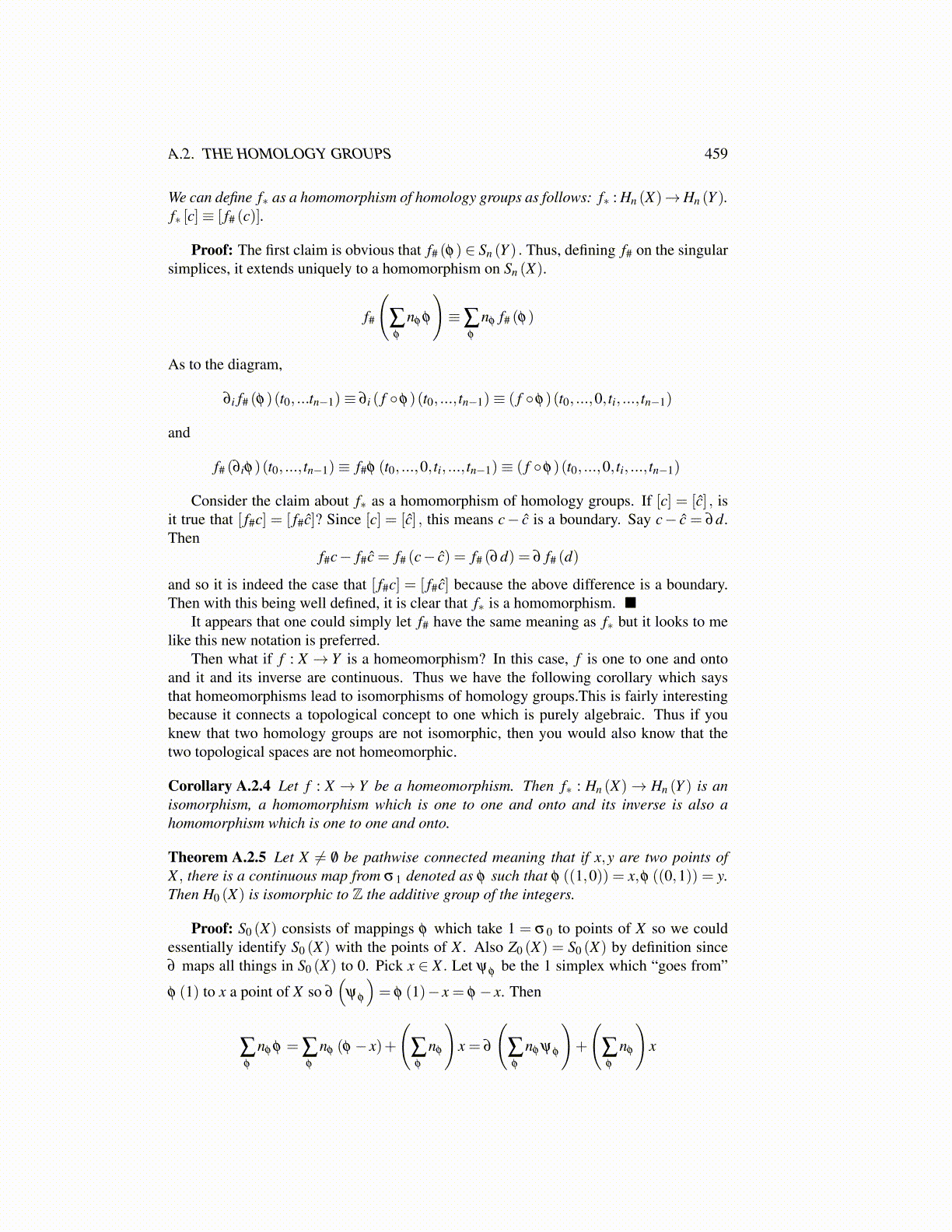
A.2. THE HOMOLOGY GROUPS 459
We can define f∗ as a homomorphism of homology groups as follows: f∗ : Hn (X)→Hn (Y ).f∗ [c]≡ [ f# (c)].
Proof: The first claim is obvious that f# (φ) ∈ Sn (Y ) . Thus, defining f# on the singularsimplices, it extends uniquely to a homomorphism on Sn (X).
f#
(∑φ
nφ φ
)≡∑
φ
nφ f# (φ)
As to the diagram,
∂i f# (φ)(t0, ...tn−1)≡ ∂i ( f ◦φ)(t0, ..., tn−1)≡ ( f ◦φ)(t0, ...,0, ti, ..., tn−1)
and
f# (∂iφ)(t0, ..., tn−1)≡ f#φ (t0, ...,0, ti, ..., tn−1)≡ ( f ◦φ)(t0, ...,0, ti, ..., tn−1)
Consider the claim about f∗ as a homomorphism of homology groups. If [c] = [ĉ] , isit true that [ f#c] = [ f#ĉ]? Since [c] = [ĉ] , this means c− ĉ is a boundary. Say c− ĉ = ∂d.Then
f#c− f#ĉ = f# (c− ĉ) = f# (∂d) = ∂ f# (d)
and so it is indeed the case that [ f#c] = [ f#ĉ] because the above difference is a boundary.Then with this being well defined, it is clear that f∗ is a homomorphism. ■
It appears that one could simply let f# have the same meaning as f∗ but it looks to melike this new notation is preferred.
Then what if f : X → Y is a homeomorphism? In this case, f is one to one and ontoand it and its inverse are continuous. Thus we have the following corollary which saysthat homeomorphisms lead to isomorphisms of homology groups.This is fairly interestingbecause it connects a topological concept to one which is purely algebraic. Thus if youknew that two homology groups are not isomorphic, then you would also know that thetwo topological spaces are not homeomorphic.
Corollary A.2.4 Let f : X → Y be a homeomorphism. Then f∗ : Hn (X)→ Hn (Y ) is anisomorphism, a homomorphism which is one to one and onto and its inverse is also ahomomorphism which is one to one and onto.
Theorem A.2.5 Let X ̸= /0 be pathwise connected meaning that if x,y are two points ofX , there is a continuous map from σ1 denoted as φ such that φ ((1,0)) = x,φ ((0,1)) = y.Then H0 (X) is isomorphic to Z the additive group of the integers.
Proof: S0 (X) consists of mappings φ which take 1 = σ0 to points of X so we couldessentially identify S0 (X) with the points of X . Also Z0 (X) = S0 (X) by definition since∂ maps all things in S0 (X) to 0. Pick x ∈ X . Let ψφ be the 1 simplex which “goes from”
φ (1) to x a point of X so ∂
(ψφ
)= φ (1)− x = φ − x. Then
∑φ
nφ φ = ∑φ
nφ (φ − x)+
(∑φ
nφ
)x = ∂
(∑φ
nφ ψφ
)+
(∑φ
nφ
)x